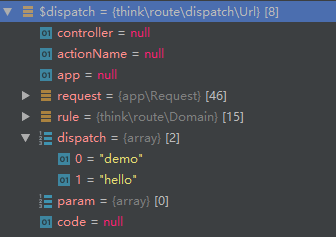ThinkPHP6 核心分析(六):Url 解析
说明
更新日志:2019-10-28 更新到6.0正式版
接第四篇,继续分析Http类的run方法里面调用的runWithRequest方法:
protected function runWithRequest(Request $request)
{
.
.
.
// 设置开启事件机制
$this->app->event->withEvent($this->app->config->get('app.with_event', true));
// 监听HttpRun
$this->app->event->trigger(HttpRun::class);
return $this->app->middleware->pipeline()
->send($request)
->then(function ($request) {
return $this->dispatchToRoute($request);
});
}这里从$this->dispatchToRoute($request)展开分析,在配置文件中关闭路由解析,即在config/app.php中将 with_route设置为false。以下分析假设访问的URL为www.tp6.com/demo/hello,并创建好了Demo控制器和hello操作——其代码如下:
<?php
namespace app\controller;
use app\BaseController;
class Demo extends BaseController
{
public function hello($name = 'ThinkPHP6')
{
return 'hello,' . $name;
}
}Url解析
dispatchToRoute方法:
protected function dispatchToRoute($request)
{
$withRoute = $this->app->config->get('app.with_route', true) ? function () {
$this->loadRoutes();
} : null;
return $this->app->route->dispatch($request, $withRoute);
}主要逻辑都在dispatch方法:
public function dispatch(Request $request, $withRoute = null)
{
$this->request = $request;
$this->host = $this->request->host(true);
//加载路由配置、缓存等
$this->init();
if ($withRoute) {
//加载路由
$withRoute();
$dispatch = $this->check();
} else {
//如果没有开启路由,将执行这里的语句
//$this->path()得到PATHINFO,比如/demo/hello
$dispatch = $this->url($this->path());
}
// $dispatch是think\route\dispatch\Url的实例,该类继承了Controller类
// 且该类中没有init方法,所以这里执行的是其父类的init方法
$dispatch->init($this->app);
return $this->app->middleware->pipeline('route')
->send($request)
->then(function () use ($dispatch) {
return $dispatch->run();
});
}因为前面设置关闭了路由解析,所以这里执行到else的语句:$dispatch = $this->url($this->path());,解析Url。Url方法如下:
public function url(string $url): UrlDispatch
{
// 第三个参数为PATHINFO
return new UrlDispatch($this->request, $this->group, $url);
}该方法新建并返回一个think\route\dispatch\Url类的实例。我们来看看这个实例化都做了些什么。think\route\dispatch\Url类的构造函数:
public function __construct(Request $request, Rule $rule, $dispatch, array $param = [], int $code = null)
{
$this->request = $request;
$this->rule = $rule;
// 解析默认的URL规则
$dispatch = $this->parseUrl($dispatch);
parent::__construct($request, $rule, $dispatch, $this->param, $code);
}最主要的逻辑是在parseUrl方法:
protected function parseUrl(string $url): array
{
// 获取URL分隔符
$depr = $this->rule->config('pathinfo_depr');
// $this->rule->getRouter() 获取路由对象
// 获取路由绑定
$bind = $this->rule->getRouter()->getDomainBind();
if ($bind && preg_match('/^[a-z]/is', $bind)) {
$bind = str_replace('/', $depr, $bind);
// 如果有模块/控制器绑定
$url = $bind . ('.' != substr($bind, -1) ? $depr : '') . ltrim($url, $depr);
}
// $path为[控制器,操作]这样组成的数组,如["demo", "hello"]
$path = $this->rule->parseUrlPath($url);
if (empty($path)) {
return [null, null];
}
// 解析控制器
// 获取控制器名
$controller = !empty($path) ? array_shift($path) : null;
// 检查控制器是否合法
// 正则匹配:开头是字母,后面是0个到多个字母、下划线或者点
if ($controller && !preg_match('/^[A-Za-z][\w|\.]*$/', $controller)) {
throw new HttpException(404, 'controller not exists:' . $controller);
}
// 解析操作
$action = !empty($path) ? array_shift($path) : null;
$var = [];
// 解析额外参数
if ($path) {
// 正则匹配:一个至多个字母,下划线,中间是‘|’,结尾是非‘|’的任意字符,比如 hello|123
preg_replace_callback('/(\w+)\|([^\|]+)/', function ($match) use (&$var) {
$var[$match[1]] = strip_tags($match[2]);
}, implode('|', $path));
}
$panDomain = $this->request->panDomain();
if ($panDomain && $key = array_search('*', $var)) {
// 泛域名赋值
$var[$key] = $panDomain;
}
// 设置当前请求的参数
$this->param = $var;
// 封装路由
$route = [$controller, $action];
// 如果路由被定义过
if ($this->hasDefinedRoute($route)) {
throw new HttpException(404, 'invalid request:' . str_replace('|', $depr, $url));
}
return $route;
}整个过程有点繁琐,分析见注释,该方法最后返回一个控制器和操作组成的数组,大概类似这样:[$controller, $action]。
最终,dispatch方法的$dispatch = $this->url($this->path());语句得到一个think\route\dispatch\Url类的实例。该实例大概长这样:
本作品采用《CC 协议》,转载必须注明作者和本文链接




 关于 LearnKu
关于 LearnKu




推荐文章: